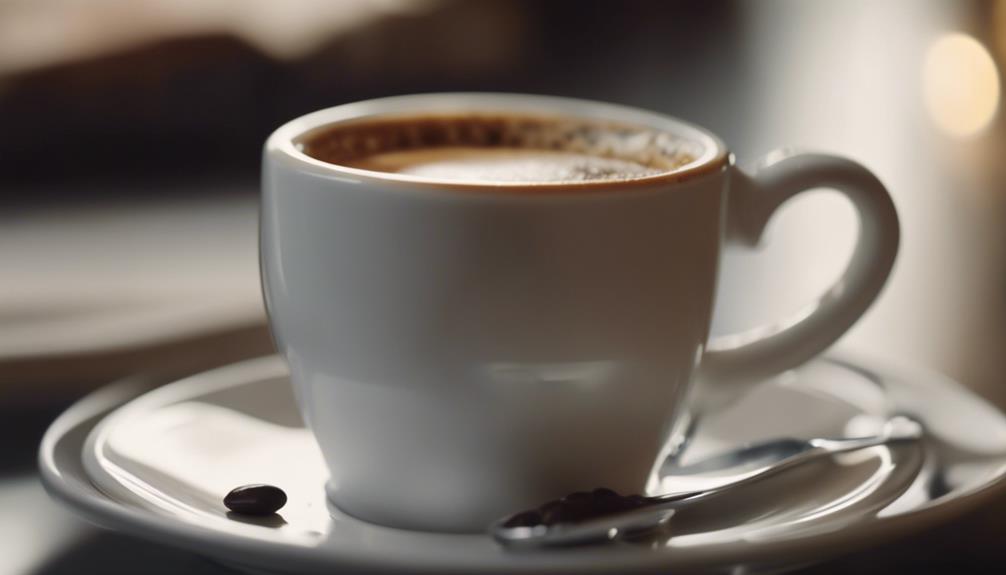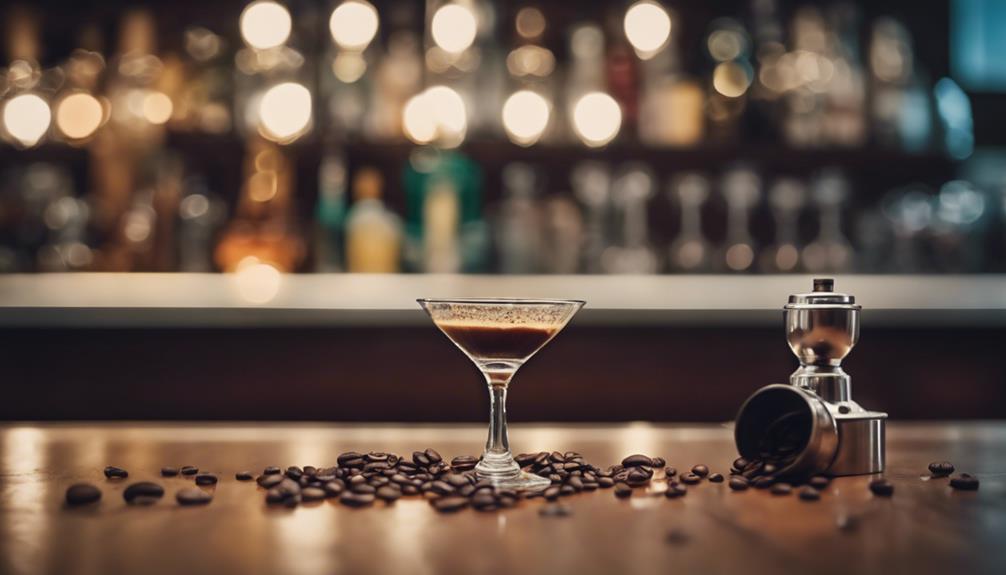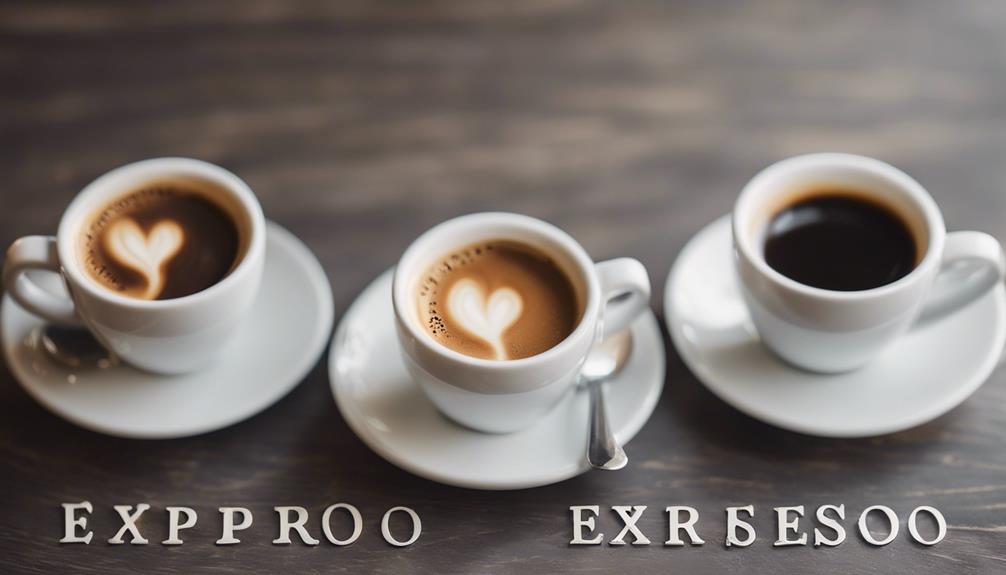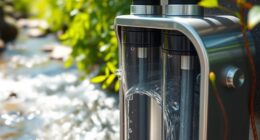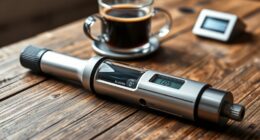Espressos can last for up to two weeks in airtight containers, but factors like air exposure, moisture, and heat can affect their freshness. It is important to store espresso properly to prevent degradation. Darker roasts generally have a longer shelf life than lighter ones. Oxidation from air can impact the taste of espresso, so it is best consumed immediately or stored in an airtight container. Room temperature can also affect the shelf life of espresso due to oxidation. It is recommended to store espresso in cool, dark places away from heat and light. For the best taste, stir the espresso, consume it promptly, and keep the shots warm. Remember to store your espresso mindfully to safeguard its freshness.
Key Takeaways
- Ground espresso lasts up to two weeks in an airtight container.
- Proper storage shields espresso from air, moisture, and heat.
- Dark roasts have longer shelf life compared to light roasts.
- Immediate consumption prevents oxidation and flavor degradation.
- Storing at room temperature accelerates oxidation and reduces shelf life.
Factors Affecting Espresso Freshness
To maintain the freshness of your espresso, understanding the key factors that impact its quality is essential. Oxygen exposure is a significant culprit in espresso staleness, leading to rapid oxidation that affects its flavor and aroma.
Heat sources can also accelerate the breakdown of oils and aromatics in espresso, diminishing its overall quality. Moisture exposure poses another threat, as it can promote mold growth in espresso grounds, further impacting freshness.
To combat these factors, storing your ground espresso in an airtight container away from light is vital. This method helps preserve the freshness of your espresso, extending its shelf life and ensuring a more flavorful experience.
Understanding Espresso Shelf Life
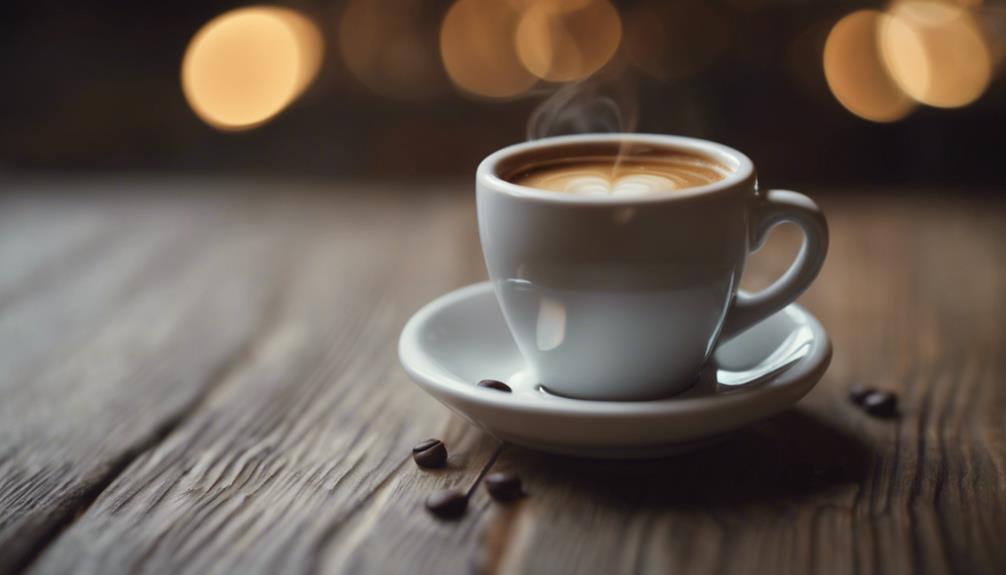
Ground espresso can maintain its freshness for up to two weeks when stored properly in an airtight container. The shelf life of ground espresso is influenced by factors such as air exposure, moisture, heat sources, and the oxidation process.
To preserve the flavor and aroma of your espresso shot, it's important to store it in an airtight container, shielding it from light, heat, and humidity. The proper storage of ground espresso helps to prevent the oxidation of the roasted beans, which can compromise the quality of your brew.
Darker roasts generally have a longer shelf life compared to lighter roasts when ground. For the best-tasting espresso, use your freshly ground beans within two weeks of storage.
Impact of Oxidation on Espressos

Oxidation in espressos greatly impacts their taste and quality, leading to rapid degradation if not managed effectively. When espressos are exposed to air, the process of oxidation accelerates, causing them to become stale quicker.
Immediate consumption is advisable to prevent the negative consequences of oxidation on the flavor profile. Storing espressos in an airtight container is a practical way to slow down the oxidation process, preserving their freshness for a longer period.
However, it's important to note that room temperature storage can also contribute to a shortened shelf life for espressos due to oxidation. To maintain the quality of your espressos and enjoy the full-bodied flavor they offer, it's crucial to minimize their exposure to air and store them appropriately in airtight containers.
Proper Espresso Storage Techniques

For peak freshness, make sure proper storage techniques are employed for your fresh ground espresso. Ground espresso should be stored in an airtight container to preserve its flavor and aroma. When stored correctly, away from air, moisture, heat, and light, ground espresso can last up to two weeks. It is crucial to avoid freezing ground espresso unless necessary, as freezing may impact its flavor negatively. Darker roasts generally have a longer shelf life compared to lighter roasts once they are ground. Proper storage involves sealing the container tightly and keeping it away from sunlight and moisture to maintain the best possible freshness.
| Proper Storage Techniques | Description |
|---|---|
| Use an airtight container | Preserve flavor and aroma by preventing exposure to air. |
| Keep away from heat and light | Protect the grounds from deteriorating due to heat and light exposure. |
| Avoid freezing | Freezing can affect the flavor of the espresso. |
| Seal container tightly | Prevent air and moisture from entering the container. |
| Store in a cool, dark place | Maintain freshness by keeping the container away from sunlight and heat sources. |
Enhancing Espresso Taste Experience
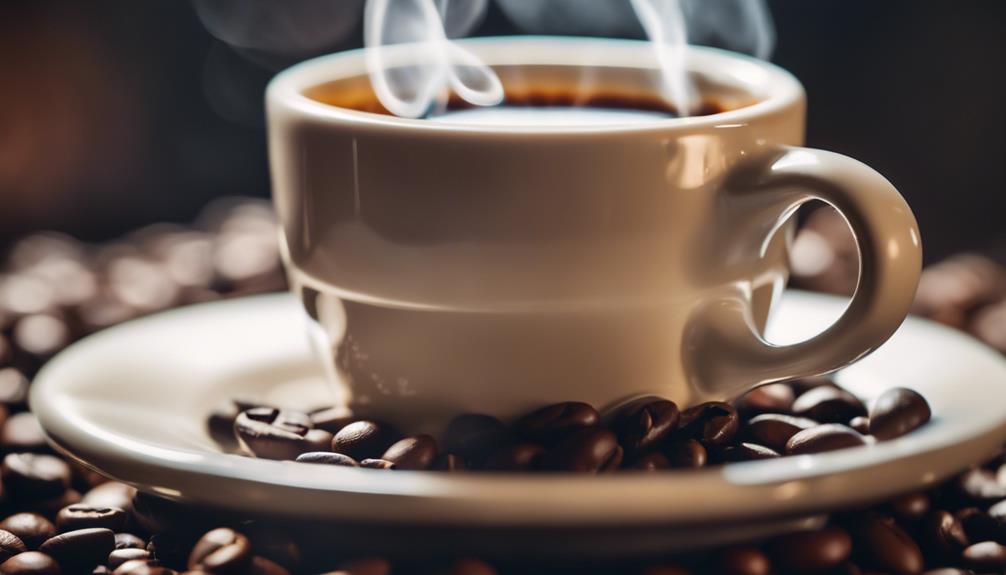
Looking to enhance your espresso taste experience? Here are some tips to make the most of your shot:
- Stir it up: Mixing the crema back into the espresso can help blend the flavors, enhancing your overall taste experience.
- Don't wait too long: Espressos can undergo oxidation within seconds, affecting the flavor profile. Consume your shot promptly after brewing for the best taste.
- Watch the clock: To savor the full range of flavors, aim to drink your espresso within a minute of it being brewed.
- Mind the temperature: Temperature variations can impact the flavor of your espresso. While cold espresso may not be as enjoyable, freshly brewed and warm espresso tends to offer the top taste.
Evaluating Espresso Age Effects
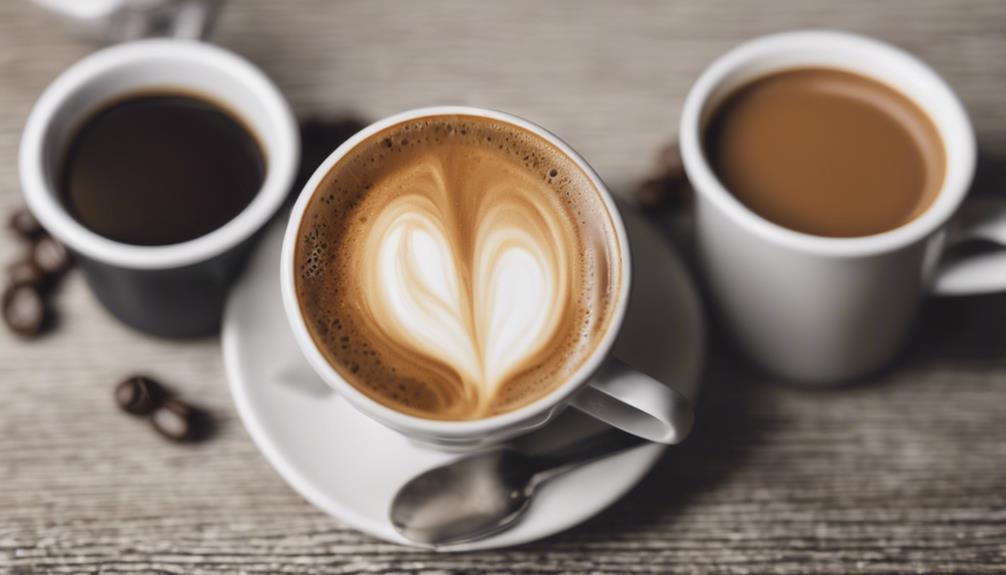
To assess the impact of espresso age on taste and quality, consider the findings from studies analyzing shot times, taste degradation, and storage methods.
Ground espresso stored at room temperature for a day or two generally showed no taste degradation. Shot times remained consistent across different roasts in 359 analyzed shots, indicating that freshness mightn't heavily influence this aspect.
Grind age, according to research, didn't notably affect taste, Extraction Yield, or shot time. Surprisingly, no clear trend between grind age and shot time was observed in the data analysis, suggesting that other factors may play a more significant role in these outcomes.
Refrigerator storage of espresso grounds may potentially assist in maintaining freshness and taste quality, emphasizing the importance of proper storage methods to extend the shelf life of your espresso.
As you explore evaluating espresso age effects, understanding these nuances can help you appreciate the complexities involved in preserving the freshness of your favorite brew.
Comparing Fresh Vs. Aged Espressos
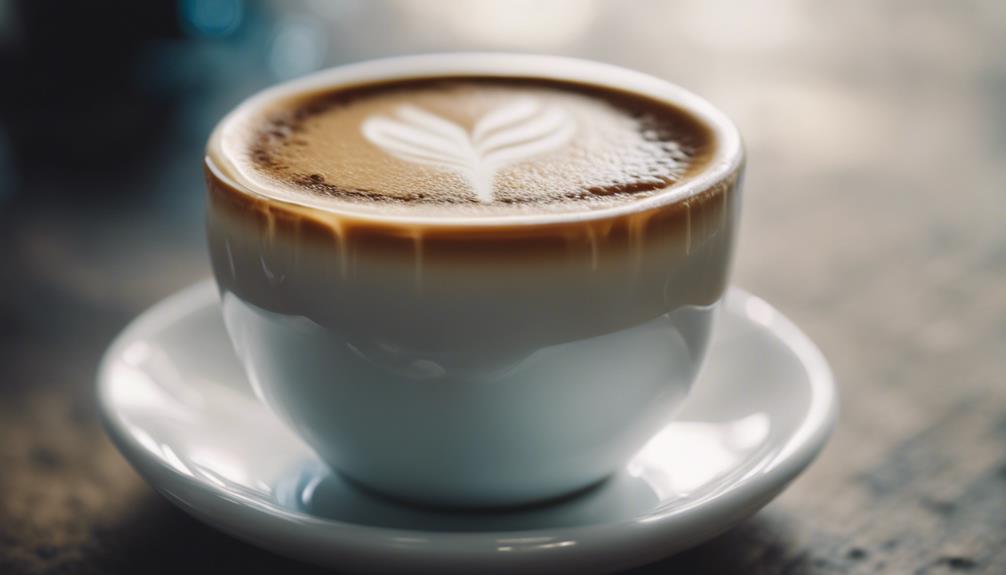
When comparing fresh espressos to aged ones, you'll notice a significant difference in taste over time. Fresh espressos boast vibrant flavors, while aged ones may develop a more bitter taste due to oxidation.
These flavor profile changes highlight the importance of consuming espresso promptly to savor its premium qualities.
Taste Over Time
Fresh espresso shots burst with vibrant flavors and aromas, peaking within the first 30 seconds after brewing, contrasting starkly with the potential bitter, sour, or acidic tastes that aged espressos may develop over time.
When comparing fresh and aged espressos, the difference in taste over time becomes evident. Here's what you need to know:
- Immediate Flavor Impact: Fresh espresso offers a robust and intense flavor profile due to the immediate release of oils and compounds, creating a delightful sensory experience.
- Oxidation Effects: Aged espresso undergoes oxidation, leading to the breakdown of coffee compounds and the emergence of bitter, sour, or acidic notes that alter the overall taste.
- Crema Disintegration: The layer of crema on fresh espresso dissipates quickly, affecting the texture and flavor intensity, while aged espressos lose this defining characteristic within seconds.
- Recommended Consumption: To savor the full essence of espresso before taste degradation occurs, it's advised to consume it promptly after brewing for the most enjoyable experience.
Flavor Profile Changes
Experience a shift in flavor profiles when comparing freshly brewed espresso to aged counterparts. Fresh espresso delights with vibrant flavors, intense aromas, and a perfectly balanced acidity profile that dances on your palate.
In contrast, aged espressos may present muted flavors, diminished aromas, and a subtle but distinct bitterness that lingers. The aging process can also impact the crema, with aged shots sometimes lacking the velvety texture that fresh espresso boasts.
As time passes, the taste notes in aged espresso evolve, leading to the fading of fruity or floral tones that were once prominent in the freshly brewed counterpart. By sampling fresh and aged espressos side by side, you can witness firsthand the transformation in flavors and textures that occurs over time.
This comparison provides a unique opportunity to appreciate how espresso evolves and how its flavor profile changes with aging.
Health Considerations With Espressos

Properly storing ground espresso in airtight containers at room temperature can help reduce health risks associated with contamination. When considering health aspects related to espresso consumption, it's important to be mindful of a few key points:
- Contamination Risks: Improper storage can lead to mold growth or bacterial contamination, impacting the safety of consuming espresso.
- Freshness for Best Taste: Freshly ground espresso beans provide a richer flavor profile, ensuring a more enjoyable coffee experience.
- Taste Alterations: Exposure to air, light, or moisture can cause espresso to develop bitter, sour, or acidic flavors, diminishing the overall taste quality.
- Expiration Date: Ground espresso should ideally be used within two weeks of grinding to maintain its peak freshness and taste.
Maintaining Freshness in Espresso Shots
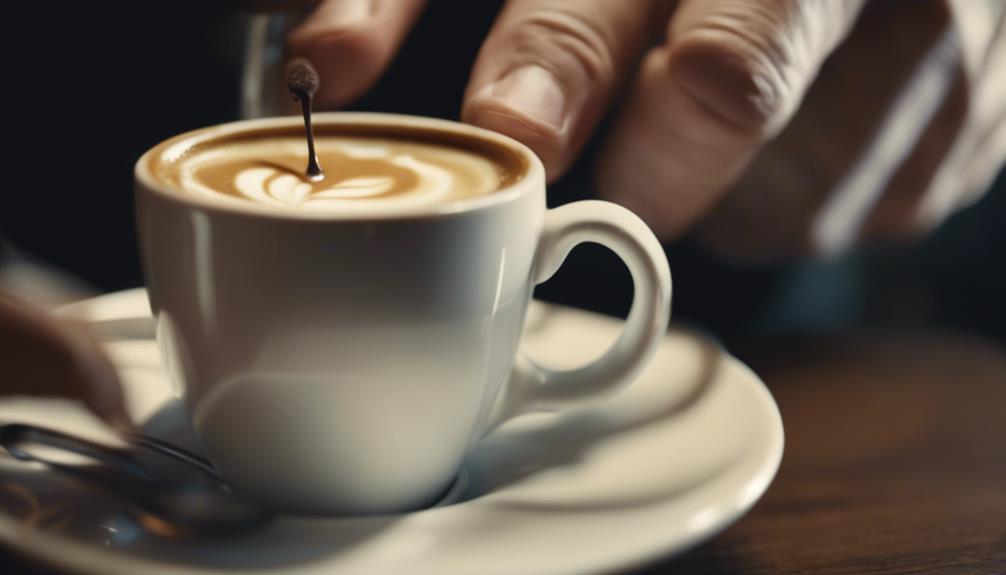
To ensure the best taste experience, it's essential to consume espresso shots within one minute of extraction. The crema, that beautiful layer on top of your shot of espresso, plays a vital role in flavor preservation. It reintegrates with the liquid, enhancing the overall taste profile.
Oxidation and degradation can quickly impact the quality of your espresso shots, so it's best to savor them promptly. Starbucks advises against letting your espresso shots sit for extended periods to maintain freshness.
If you want to enhance your espresso experience further, try stirring your shot before drinking. This simple action can help mix the flavors and aromas, ensuring a more balanced taste.
Frequently Asked Questions
How Long Does Espresso Stay Fresh?
Espresso stays fresh for a brief window of time, ideally within a minute of being brewed.
The crema, that lovely golden layer, quickly blends with the liquid, enhancing the taste and aroma.
However, after about 10 seconds, oxidation starts to alter the flavor.
Starbucks advises against letting your espresso linger too long, as flavor can degrade rapidly.
For that perfect espresso experience, savor it promptly after it's made.
What Is the Lifespan of Espresso?
Espresso's lifespan is brief; its flavors start to fade in about a minute after brewing. The prized crema vanishes quickly, altering the taste within 10-30 seconds.
Oxidation transforms espresso's color and flavor if left unattended for too long. Starbucks advises drinking espresso promptly for peak enjoyment.
To boost taste, stirring your espresso before sipping can blend the flavors, enhancing the overall experience.
What Is the 10 Second Rule for Espresso?
The 10-second rule for espresso advises you to consume the shot within 10 seconds of brewing to savor the best flavor profile. After this time, oxidation can occur, impacting the color and taste of the espresso shot.
To fully enjoy the nuances of your espresso, it's recommended to drink it within one minute of brewing. Remember, freshness plays a crucial role in experiencing the full range of flavors in your espresso shot.
How Long Can Espresso Sit Out Before It Goes Bad?
Espresso typically lasts around a minute before its flavor begins to decline. Letting it sit out for too long can lead to taste degradation. To keep your espresso at its best, aim to enjoy it promptly after brewing.
Remember, oxidation starts affecting the shot's color after just 10 seconds. Starbucks cautions against leaving espresso sitting for extended periods to maintain its freshness.
Stirring before sipping can help blend the crema back in and enhance the overall taste.
Can the Taste of Espresso Change Over Time?
The taste of espresso can change over time due to various factors such as the freshness of the beans, the brewing method, and storage conditions. The espresso flavor explanation lies in the volatile compounds that can degrade or evolve, causing shifts in taste profile.
What is the Shelf Life of Espresso Powder Compared to Fresh Espresso?
Espresso powder expiration date is typically around one year if stored in a cool, dry place. In comparison, fresh espresso has a much shorter shelf life of only a few weeks before it starts to lose its flavor and aroma. It’s best to use espresso powder within its recommended time frame for optimal quality.
Conclusion
To sum up, the freshness of espressos can greatly impact their taste and quality. Proper storage techniques and consumption within the recommended time frame are crucial to enjoy the full flavor of your espresso.
For instance, a study found that freshly roasted and ground espresso beans produced a more vibrant and complex flavor profile compared to beans that were stored for an extended period.
By following these guidelines, you can guarantee a consistently enjoyable espresso experience.
